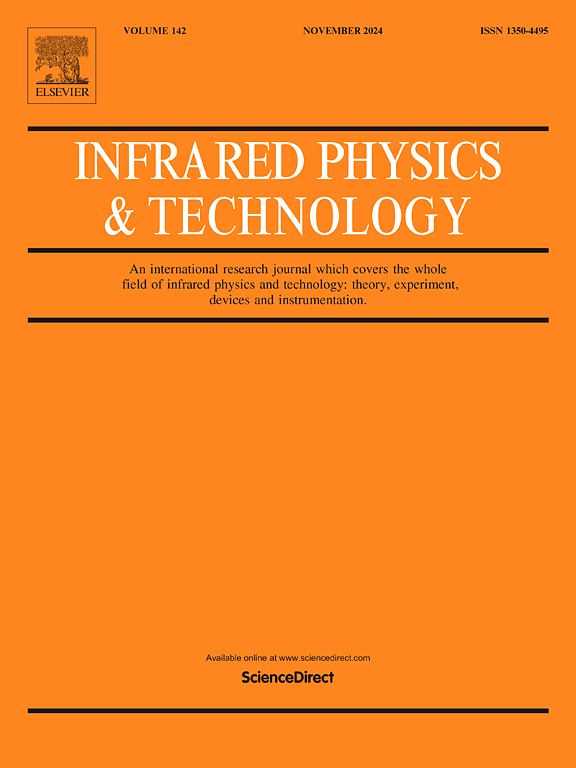用于制冷红外光谱探测器的高机械稳定性mems悬臂可调FP滤波器
IF 3.1
3区 物理与天体物理
Q2 INSTRUMENTS & INSTRUMENTATION
引用次数: 0
摘要
光谱综合探测是下一代红外 FPA 的一个重要分支,其中包括所谓的具有功能多样性的多维探测能力。对当前最先进的 FPA 技术进行这样的改进,可以实时调整从多个窄波段收集的光谱信息,使数据立方体满足在复杂的噪声环境中清晰识别目标的要求。为了提供尺寸、重量和功耗(SWaP)更小的解决方案,我们开发了基于微机电系统(MEMS)的电可调滤波器技术。所采用的这种方法能够利用直接集成在 FPA 芯片上的可调谐 MEMS 光学滤波器获得窄带光谱灵敏度,从而提供片上光谱探测器。特别是在与冷却红外 FPA 集成时,需要应对低温真空环境下与 FPA 芯片面积相匹配的大尺寸滤波器的可靠性和稳定性挑战。本文还进行了多物理场耦合分析工作,以了解机电特性的稳定性能。然后,我们制作了基于 MEMS 的可调谐 FP 滤波器,在半径为 3 毫米的滤波器区域内,其传输率达到 45%,均匀性良好,在电压偏置下的最大调谐波长范围为 0.7 μm(从 5.3 μm 到 4.6 μm)。我们将调谐滤波器与 InAs/GaSb Type-II 超晶格红外探测器集成在一起,并在液氮温度下测试了可调谐光响应性能。所有这些工作都为我们下一步工作中与冷却 FPA 集成奠定了基础。本文章由计算机程序翻译,如有差异,请以英文原文为准。
High mechanical stability MEMS-based cantilever tunable FP filter for cooled infrared spectral detector
Spectral integrated detection is one of important branch anticipated for the next generation infrared FPA, which includes so-called multi-dimensional detection capabilities with function diversity. Such enhancement of the current state-of-the-art FPA technologies allow real-time tuning of spectral information to be gathered from multiple narrow wavelength bands, getting data-cube to meet the requirements of clear target recognition in complex noisy scenarios. In order to provide a reduced size, weight and power (SWaP) solution, microelectromechanical systems (MEMS) based electrically tunable filter technology has been developed. This adopted approach is capable of delivering on-chip spectral detector by obtaining narrow-band spectral sensitivity utilizing tunable MEMS optical filter directly integrated on FPA chips. Especially for integration with cooled infrared FPA, it is necessary to meet the reliability and stability challenges of large-sized filters matching FPA chip area under low-temperature vacuum environment. In this paper, a multi physics field coupling analysis work was also dug out for understanding the stability performance of electromechanical characteristics. Then we produced MEMS based tunable FP filters, which demonstrated a transmission of 45 % with a well uniformity within the filter area of 3 mm radius, and maximum tuning wavelength range of 0.7 μm (from 5.3 to 4.6 μm) under voltage bias. We integrated the tuning filter with InAs/GaSb Type-II superlattice infrared detector and tested the performance of tunable photo-responsivity at liquid nitrogen temperature. All the work laid the foundation for integration with cooled FPA in our next step work.
求助全文
通过发布文献求助,成功后即可免费获取论文全文。
去求助
来源期刊
CiteScore
5.70
自引率
12.10%
发文量
400
审稿时长
67 days
期刊介绍:
The Journal covers the entire field of infrared physics and technology: theory, experiment, application, devices and instrumentation. Infrared'' is defined as covering the near, mid and far infrared (terahertz) regions from 0.75um (750nm) to 1mm (300GHz.) Submissions in the 300GHz to 100GHz region may be accepted at the editors discretion if their content is relevant to shorter wavelengths. Submissions must be primarily concerned with and directly relevant to this spectral region.
Its core topics can be summarized as the generation, propagation and detection, of infrared radiation; the associated optics, materials and devices; and its use in all fields of science, industry, engineering and medicine.
Infrared techniques occur in many different fields, notably spectroscopy and interferometry; material characterization and processing; atmospheric physics, astronomy and space research. Scientific aspects include lasers, quantum optics, quantum electronics, image processing and semiconductor physics. Some important applications are medical diagnostics and treatment, industrial inspection and environmental monitoring.

 求助内容:
求助内容: 应助结果提醒方式:
应助结果提醒方式:


